![]()
![]()
This is a page on learning how the ENGINE works. I've been getting a lot of E-Mail from school students on this so I decided to make web page so every one that wants to know How and Why don't have to write to me. Because sometimes it takes me awhile to write back. They can just visit this page. I will answer every E-Mail I get. You can still write to me if you don't understand something. Or need other information that's not on the page.
I'm trying to make my pages on the INTERNAL COMBUSTION ENGINE very informative. I'm going to try to break it up in sections for easy reading and understanding.
So let's get started. Use the links below to jump around or start at the beginning. If you have any questions feel free to write to me.
![]()
| 1. UNDERSTANDING THE FUEL | 2. UNDERSTANDING THE INTAKE |
| 3. UNDERSTANDING COMPRESSION | 4. WHERE THE POWER COMES FROM |
| 5. WHAT HAPPENS AFTER THE POWER | 6. BACK TO THE MAIN PAGE |
First you have to have something to power the engine ,a fuel, in this case we use gas as the fuel. Gas as a liquid will not burn, believe that. Well it's true. The gas is mixed with air to make a vapor (gas vapor burns). The PERFECT mixture of gas and air is 14 parts air and 1 part gas. So the perfect mixrure would be 14 to 1. This is done by the carbuator or fuel injection.
| When you turn the key to start your car the starter turns the engine as the engine turns the pistons move up and down and suck in the gas vapor through the carb. intake and valves into the cylinder. We'll get into a lot of this later.
The carbuator mixes the air and gas through the carbuator throat . As the air rushes past the venturi in the carbuator throat it sucks gas from the carbuator bowl and the gas and air mix making a gas vapor. As you push on the gas pedal the throttle opens more and allows more air to be sucked through the throat. The more air goes through the throat the more gas it suck out of the venturi. That means you go faster.
|
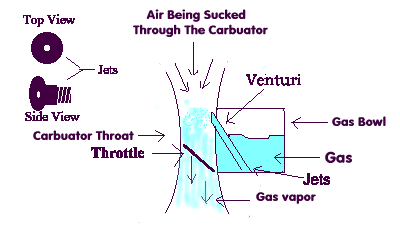 |
NOTE: The throat of the carb. is known as the barrel of the carb. I'm sure you have heard some one talk about 2 barrel and 4 barrel carb. So the more barrels you have the more gas you can give the engine.Carbs are made in 1 barrel, 2 barrels, and 4 barrels. I didn't want you to think you could buy a lets say 10 barrel carb. You can't. But with special made intake manifolds you can put more than one carb on. Like two 4 barrels or 3 two barrel carbs (also know as 3 duces).
Well now that we know some of how the engine gets the fuel we can move on.
Back to the LINKS
Now that you know what an engine burns for fuel. In the next couple chapters we'll show you how the engine turns that fuel (gas) into power. To run your car ,go cart, lawn mower, etc
| As the carb mixes the gas and air to make a gas vapor to burn. It is sucked through the carb and then through the intake manifold ( we will talk about intake maniflds later) to the cylinders. The intake manifold is what the carb is bolted to. The purpose of the intake manifold is to distribute the gas vapor to each intake valve for each cylinder. The camshaft ( we will talk about camshafts later, right now you just need to know how the gas gets into the cylinder) will open the intake valve when the piston is on the intake stroke ( down ward motion) sucking in gas vapor into the cylinder. When the piston reaches the bottom of the intake stroke the intake valve will close before the piston starts back upward on the compression stroke. At least now you should understand how the gas gets into the engine. Now on to the compression stroke.
The pictures on the right are of a lawn mower engine. Engines work on the same principle weather there in your car or on your lawn mower.
|
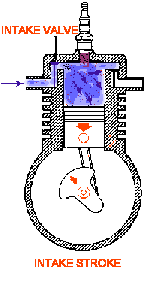 |
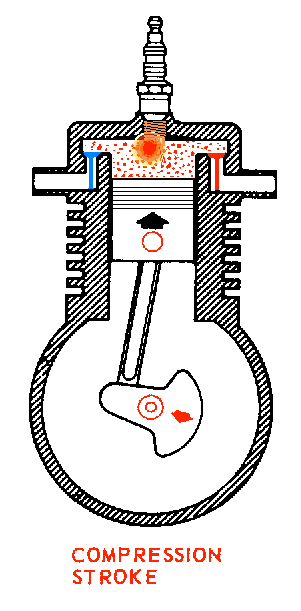 |
Ok so far we know that carb. mixes the gas and air to make a gas vapor so it can burn. And the gas vapor gets into the cylinder by the INTAKE VALVE opening on the INTAKE stroke (down ward motion) of the piston. And the intake valve closes when the piston gets to the bottom of the intake stroke. So now we have a cylinder full of gas vapor the intake valve is closed (it's a closed chamber, nothing can get out) and the piston is starting on the compression stroke (up ward motion). It's called the compression stroke because by the time the piston gets to the top or end of the compression stroke it's going to squeeze (compress) all that gas vapor into a tiny little space between the head and the piston. Alright let's do a little math (I know just what you wanted to do,right) so you understand it a little better. Let's take a big block Chevy engine a 454cu. in. There are 8 cylinders that have 454 cubic inchs within them. So divide 454 by 8 and you get 56.75 cubic inchs per cylinder. What this means is it will take 56.75 cubic inchs of gas vapor to fill the cylinder when the intake stroke is done. What's a cubic inch? A cubic inch is a 1 inch square on all sides. Think of it kind of like an ice cube, only 1 inch on each side. Now if you have an engine in this case our 454cu. in. Big block Chevy that has a 10 to 1 compression ratio, by that I mean it will take 10 cubic inches of gas vapor and compress it into a 1 inch space. Back to our math,If each cylinder has 56.75 cubic inches of gas vapor and we have a 10 to 1 ratio it compress that into (56.75 / 10 = 5.67) 5.67 cubic inches of space. I hope this helps you understand what compression is. |
| We now have a closed cylinder full of COMPRESSED gas vapor. The piston is at the top or end of the compression stroke. We need something to lite the gas vapor so it will burn. Yep, you guessed it the spark plug. When the spark plug sparks it ignites the compressed gas vapor . It does not just burn. It BLOWS UP with a tremendous force. Which pushes the piston down ward. This is called the POWER STROKE. This is how your engine gets it's power. Let's see if you know how and why you car or lawn mower or any gas powered engine runs faster. Do you know? Really you should know from what you have read here so far. When you tramp on the gas pedal in your car you are opening the throttle (look at the picture in understanding the Fuel) which allows more air to pass through the carb and that in turn mixes more gas with the air. So what you are doing is putting more gas and air into the cylinder. the more gas the bigger the explosion when the spark ignites the gas vapor the faster it will push the piston down ward.
Sounds pretty simple doen't it! It is really. There's a lot more to it then this but , this is just the BASICS on how the Engine works.
|
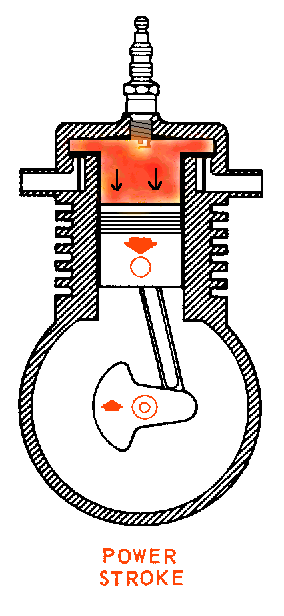 |
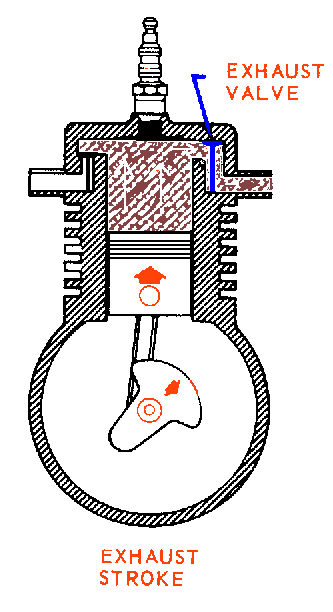 |
Well now were at the last stroke of a 4 stroke engine. You should be able to name at least 3 of them. Well can you? If you said :
It's the 4. EXHAUST STROKE. We have to get rid of the burn gas in the cylinder some how.
Here's how it's done . The piston is the bottom or end of the power stroke as the piston starts back upward the EXHAUST VALVE opens allowing the piston to push all tha burn gas out of the cylinder. This should help you understand the basics of how an engine runs. If you need more information feel free to WRITE to me. |
![]()